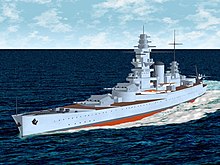French battleship Dunkerque
This article includes a list of references, related reading, or external links, but its sources remain unclear because it lacks inline citations. |

| |
| History | |
|---|---|
| Namesake | City of Dunkirk |
| Laid down | 24 December 1932 |
| Launched | 2 October 1935 |
| Commissioned | 1 May 1937 |
| Homeport | Toulon |
| Fate | Scuttled 27 November 1942 |
| General characteristics | |
| Class and type | Dunkerque class battleship |
| Displacement | 26,500 tonnes |
| Length | 215.1 m |
| Beam | 31.1 m |
| Draught | 8.7 m |
| Propulsion | list error: <br /> list (help) 6 Indret boilers 4Rateaugearedturbines 135,585hp |
| Speed | 31 knots |
| Range | 13,900 km |
| Complement | 1381 |
| Armament | list error: <br /> list (help) 8 330mm/50 Modèle 1931 guns in quadruple turrets 3xquadrupleand2xdouble130mmAAturrets 5xdouble37mmAAturrets 4xdoublemmAAturrets |
| Armour | list error: <br /> list (help) 225 mm (side belt) 30mm(anti-torpedobulkheads) 125-115mm(deck) 330-310mm(turrets) |
| Aircraft carried | list error: <br /> list (help) 4 hydroplanes 1catapult |
The Dunkerque was the first of a new class of warship of the French Navy labeled as a "fast battleship".
Not as well-armed and considerably less armoured than contemporary battleships, they are nonetheless considered scaled-down battleships and they are considerably more balanced than battlecruisers. The Dunkerques were superior in all respects to and designed to counter the threat of the German pocket battleships of the Deutschland class, which were in effect scaled-up cruisers.

The design was very innovative, having the entire main armament mounted forward in two quadruple turrets which gave unrestricted forward fire. The Royal Navy's Nelson class battleships also had the entire armament mounted forward, but in three turrets carrying nine guns, with the angles of fire for the rearmost turret limited by the turrets in front. The mounting of the main armament in quadruple turrets was a feature unique to late-design French battleships such as Dunkerque, Richelieu and Jean Bart.
During the Phoney War, Dunkerque was used along with her sister-ship Strasbourg to escort convoys.
After the collapse of France, she was docked in Mers-El-Kebir, along with Strasbourg. The sinking of these ships became one of the main objectives of the British attack on the French fleet at Mers-el-Kebir on 3 July 1940. Dunkerque was severely damaged by gunfire during this attack, settling on the bottom of the harbour. Two days later, she sustained further damage by torpedo-bombers from the aircraft carrier Ark Royal.
After being refloated and temporary repairs completed, Dunkerque returned to Toulon in February 1942. She was in armistice custody, disarmed and in drydock, when the Germans invaded the so-called "Free Zone" on 27 November 1942. She was scuttled, along with Strasbourg, in the scuttling of the French fleet in Toulon. Her commanding officer, Capitaine de vaisseau Amiel, initially refused to sink his ship without written orders, but was finally convinced to do so by the captain of the nearby light cruiser La Galissonnière. Demolition charges were ignited, destroying the ship and setting the wreckage ablaze.
-
A 330mm shell of the type used by the main armament of Dunkerque and Strasbourg.
-
3-D plan of the ship
External links
| Dunkerque class battleship |
| Dunkerque | Strasbourg |
List of battleships of France |






